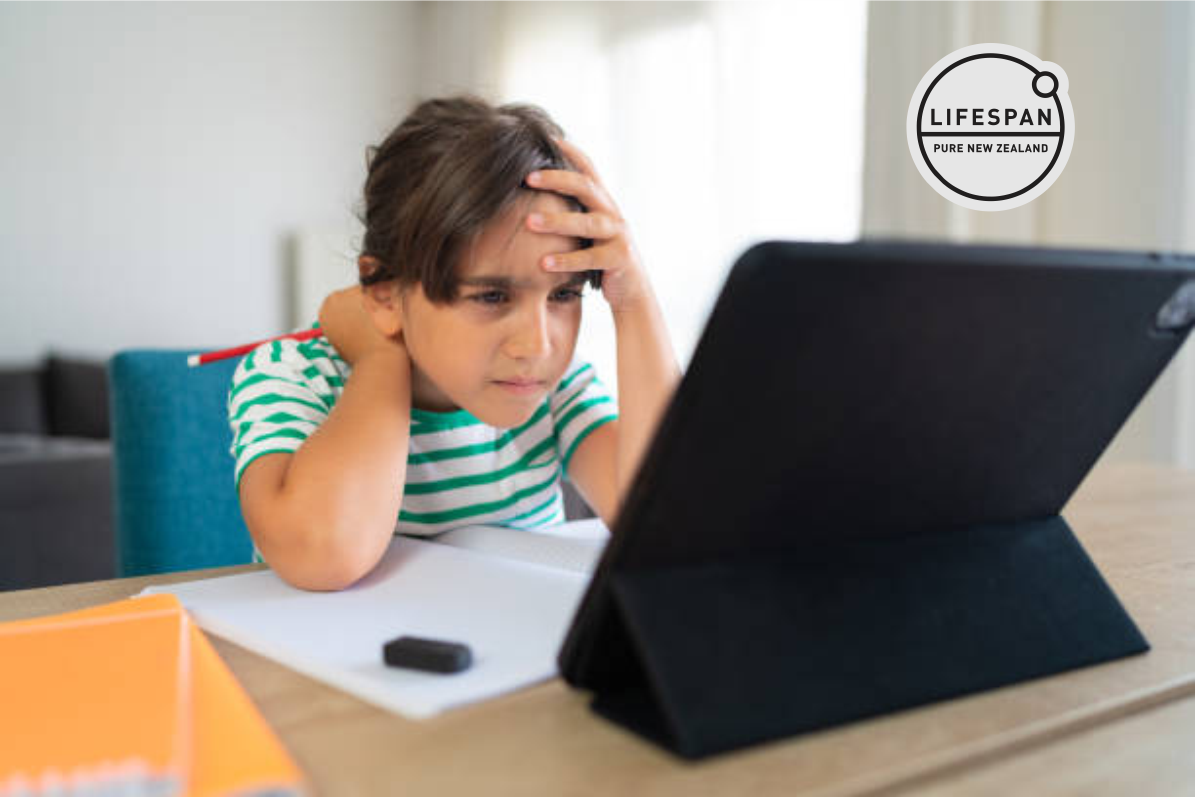
Natural eye health chews
Why Choose Bilberry?
Derived from high-quality European bilberry extract, this supplement is an excellent choice to support children's eye health.
Bilberries are known for their potential benefits in eye health, making them a natural ally against the visual demands of the digital age.
Recent posts
-

-
 Healthy Eyes for Children: Fun Activity GuideBy Ben Winters
Healthy Eyes for Children: Fun Activity GuideBy Ben Winters

About the Author
Ben Winters is a passionate advocate for natural health and wellness. With years of experience in the field of nutritional supplements, Ben has dedicated his career to developing products that not only address specific health concerns but also promote overall well-being. His expertise in utilising of natural ingredients, like the European bilberry, has led to the development of this exceptional eye health supplement.

The Impact of Screen Time on Children's Eyesight
By Ben Winters
Children's eyesight is increasingly being influenced by the screen time they are exposed to daily, through the use of mobile phones, computers and other devices. This raises concerns about the impacts on their visual health.
Screens are now a common part of everyday life, especially for children, and there are concerns about the long term effects this may have on children's eye health and eyesight.
From educational tools to entertainment sources, screens in various forms, be it TVs, tablets, mobile phones, or computers, play a significant role in the modern childhood experience. As a result, the average screen time among children has seen a remarkable increase.
Screen time refers to the amount of time spent using devices with screens, such as televisions, computers, smartphones, and tablets.
This term has become increasingly relevant as digital devices play a significant role in both the educational and recreational activities of children. Screen time is not just about watching TV; it includes a range of activities like playing video games, using educational apps, browsing the internet, and engaging in social media.
It's important to understand that not all screen time is equal; the impact on children's eyesight and overall health can vary based on the type of content and the context in which screen time occurs.
Recent studies have revealed some eye-opening statistics about screen time among children. It has been found that children are spending an increasing number of hours in front of screens. The average screen time varies by age group, with younger children typically spending less time than older children and teenagers.
These statistics have been on the rise in recent years, largely due to the integration of digital technology into educational settings and the increasing accessibility of personal devices.
When discussing screen time, it's essential to consider the variety of screens children interact with. Televisions, once the primary source of screen time, are now just one of many devices. Computers, widely used for educational purposes, add significantly to the total screen time, especially for school-aged children.
Smartphones and tablets, known for their portability and versatility, are particularly popular among children for both learning and leisure activities.
Each type of screen has its own set of characteristics, such as screen brightness and distance from the eyes, which can have differing effects on eye health.
Understanding these different types of screens gives a full picture of children's screen time. Televisions are typically viewed from a distance, potentially reducing eye strain compared to handheld devices.
Computers, often used for prolonged periods, can be a significant source of eye strain, especially if not positioned ergonomically.
Smartphones and tablets, with their smaller screens, often require more visual focus and can be used for extended periods, increasing the risk of eye fatigue.
This variety in screen types and usage patterns adds complexity to the conversation about the impact of screen time on children's eyesight.
The impact of screen time on children's eyesight can be observed both in the short term and over the long haul.
In the short term, excessive screen use often leads to eye strain. This condition, also known as computer vision syndrome, encompasses a range of eye discomfort and vision problems.
Symptoms include sore, tired eyes, blurred vision, and difficulty focusing. This is primarily due to the reduced blinking rate while focusing on screens, leading to dry eyes, a condition where the eyes don't produce enough tears or the quality of tears is poor, causing irritation.
Furthermore, prolonged screen time can contribute to headaches, a direct result of the strain placed on the visual system and potentially poor posture during screen use.
In the long term, the consequences can be more concerning.
A significant risk is the development of myopia, or nearsightedness, particularly in children who spend excessive amounts of time engaged in close-up screen activities. Myopia occurs when the eyeball grows too long, causing light rays to focus at a point in front of the retina rather than directly on its surface.
This condition can worsen with continued strain on the eyes. Moreover, there is a potential for permanent eye damage if these habits are sustained over time without proper precautions. This damage could include changes in the eye that contribute to age-related macular degeneration and other serious visual impairments in later life.
Research results support these observations and provide evidence about the importance of moderating screen time in children, to protect their long-term eyesight and overall eye health. They also underscore the importance of regular eye exams and proactive measures to mitigate these risks.
To help protect children from the risks of excessive screen time, parents and teachers can adopt several practical strategies that align with children's habits and routines.
Firstly, regulating screen time is key. This can involve setting specific time limits for device use and encouraging regular breaks. For instance, using the 20-20-20 rule, where after every 20 minutes of screen use, children are encouraged to look at something 20 feet away for 20 seconds, or take a break and do something else for a few minutes. This simple routine can greatly reduce eye strain.
Creating a child-friendly ergonomic environment is also crucial. Parents and teachers can ensure that screens are positioned at an appropriate height and distance, suited to a child's eye level and seating arrangement.
This helps in maintaining a proper posture and reduces the likelihood of eye strain. Additionally, ensuring that rooms are well-lit to minimize screen glare can be a significant step in protecting young eyes.
The use of mobile phones and other devices in bed or darkened bedrooms is increasingly common among children. Often this may be happening without the knowledge of their parents, who think their children have gone to bed to sleep.
Using devices in a dark room can cause excessive eye strain due to the high contrast between the bright screen and the surrounding darkness. This environment forces the eyes to work harder to focus, which can lead to significant discomfort, including dry eyes and headaches.
Parents should discourage the use of screens in dark settings, particularly before bedtime, as it can also disrupt sleep patterns. Encouraging children to use devices in well-lit areas and establishing a 'no screens in bed' rule can be effective strategies.
This not only helps in reducing the risk of eye strain but also promotes better sleep hygiene, contributing to overall health and well-being.
Incorporating eye health into a child's diet is another practical approach.
Parents can include in their children’s diet foods that are rich in omega-3 fatty acids, lutein, and vitamins C and E, such as leafy greens, eggs, and various berries, which are natural sources of these nutrients, and should form the foundation of a child’s diet.
In some situations, the child's diet may not provide sufficient levels of certain nutrients that are needed for optimal eye health.
In these cases supplementation with Bilberry and Lutein can be beneficial. Bilberry, rich in antioxidants like anthocyanins, has been traditionally used for supporting eye health.
These antioxidants can help to protect the eyes from oxidative stress, a factor in eye fatigue, and strain, particularly relevant for children spending considerable time on digital devices. Lutein, another antioxidant found naturally in the eyes, filters harmful blue light from screens, and supports the overall health of the eyes.
The impact of screen time on children's eyesight is an issue that requires a comprehensive approach.
Balancing screen time with other activities, ensuring proper ergonomics during device use, and maintaining a nutrient-rich diet are foundational steps. Parents and educators need to start implementing these strategies, setting a positive example, and creating an environment that prioritises eye health.
Regular breaks from screen time, using devices in well-lit areas, and following the 20-20-20 rule can significantly mitigate the risks of eye strain and long-term vision problems.
Ensuring children get a variety of nutrients from natural food sources is key, along with moderating their screen time and encouraging physical activities.
Supplementation with nutrients like Bilberry and Lutein, can also offer benefits in a holistic approach to eye care, especially when dietary intake might not be sufficient.
Ultimately, the goal is to create a balanced and healthy lifestyle for children in this digital era. Awareness and education about the potential risks of excessive screen time, and how to counteract these, are essential.
By taking these proactive steps, parents and educators can help safeguard children's eyesight, ensuring their healthy development and well-being in a world where screens are an integral part of daily life.


